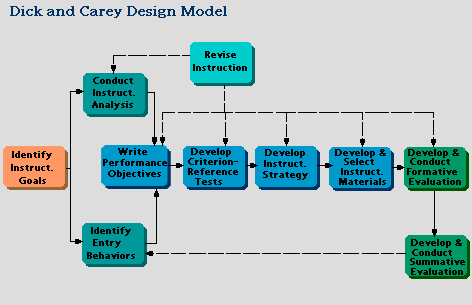Dick and Carey Model
Presentation by Hee-Sun Lee & Soo-Young
Lee
This model describes all the phases of an iterative
process that starts by identifying instructional goals and ends with
summative evaluation. This model is applicable as shown below. (See
bold faces)
|
Expertise Level
|
Novice
|
Expert
|
|
Orientation
|
Descriptive
|
Prescriptive
|
|
Knowledge Structure
|
Procedural
|
Declarative
|
|
Purpose & Uses
|
Small Scale (Unit, Module,
Lesson)
|
Large Scale (Course, Intruction)
|
|
Theoretical Basis
|
Learning Theory
|
Analysis Functions
|
|
Context
|
K-12 / Higher Education
|
Business / Government
|

(Flow chart and table from Sherri Braxton's site on
Instructional Design Models)
Stage 1. Instructional Goals
* Instructional Goal: Desirable state of affairs by
instruction
* Needs Analysis : Analysis of a discrepancy between an
instructional goal and the present state of affairs or a personal
perception of needs.
Stage 2. Instructional Analysis
* Purpose : To determine the skills involved in
reaching a goal
* Task Analysis (procedural analysis) : about the product of which
would be a list of steps and the skills used at each step in the
procedure
* Information-Processing Analysis : about the mental operations
used by a person who has learned a complex skills
* Learning-Task Analysis : about the objectives of instruction
that involve intellectual skills
Stage 3. Entry Behaviors and Learner
Characteristics
* Purpose : To determine which of the required
enabling skills the learners bring to the learning task
* Intellectual skills
* Abilities such as verbal comprehension and spatial
orientation
* Traits of personality
Stage 4. Performance Objectives
* Purpose : To translate the needs and goals into
specific and detailed objectives
* Functions : Determining whether the instruction related to its
goals.
Focusing
the lesson planning upon appropriate conditions of learning
Guiding
the development of measures of learner performance
Assisting
learners in their study efforts.
Stage 5. Criterion-Referenced Test Items
*To diagnose an individual possessions of the
necessary prerequisites for learning new skills
*To check the results of student learning during the process of a
lesson
*To provide document of students progress for parents or
administrators
*Useful in evaluating the instructional system itself (Formative/
Summative evaluation)
*Early determination of performance measures before development of
lesson plan and instructional materials
Stage 6. Instructional Strategy
* Purpose : To outline how instructional activities
will relate to the accomplishment of the objectives
*The best lesson design : Demonstrating knowledge about the
learners, tasks reflected in the objectives, and effectiveness of
teaching strategies
e.g. Choice of delivering
system.
Teacher-led,
Group-paced vs. Learner-centered, Learner-paced
Stage 7. Instructional Meterials
* Purpose : To select printed or other media intended
to convey events of instruction.
* Use of existing materials when it is possible
* Need for development of new materials, otherwise
* Role of teacher : It depends on the choice of delivery
system
Stage 8. Formative Evaluation
* Purpose : To provide data for revising and
improving instructional materials
* To revise the instruction so as to make it as effective as
possible for larger number of students
* One on One : One evaluator sitting with one learner to
interview
* Small Group
* Field Trial
Stage 9. Summative Evaluation
* Purpose : To study the effectiveness of system as a
whole
* Conducted after the system has passed through its formative
stage
* Small scale/ Large Scale
* Short period/ Long period
References
* Dick, W. & Cary, L. (1990), The Systematic Design of
Instruction, Third Edition, Harper Collins
* Briggs, L. J., Gustafson, K. L. & Tellman, M. H., Eds. (1991),
Instructional Design: Principles and Applications, Second Edition,
Educational Technology Publications, Englewood Cliffs, NJ
* Edmonds, G. S., Branch, R. C., & Mukherjee, P. (1994), A
Conceptual Framework for Comparing Instructional Design Models,
Educational Research and Technology, 42(2), pp.
55-72.
* Gagne, R. M., Briggs, L. J. & Wagner, W. W. (1992).
Principles of Instructional Design (4th ed.), Holt, Reihhart, and
Winston Inc.
Return to ED626 Class Presentations

